10 Easy Solutions to Fix ‘Outlook starting in safe mode’ Error
Most popular applications have a safe mode that enables users to run the program with limited functionality when things are not running as they should. Such is the case with Outlook – a complex email manager that uses Safe Mode to bypass a lot of issues that prevent it from starting. You might launch Outlook in Safe Mode on purpose, but it might also start in this mode on its own.
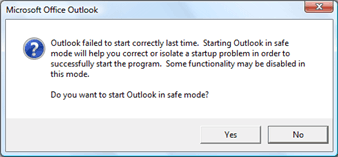
Unless you initiated the Safe Mode yourself for whatever reasons, I won’t advise you to continue using Outlook in this mode. You won’t be able to save templates, preferences and you won’t be able to use smart tags, among others. If you’re in this type of situation, it’s recommended that you treat Safe Mode as a diagnostic tool and resolve your problem.
When is Safe Mode used in OutLook
Outlook will regularly update the system registry to allow the new extensions you install to function as they should. If the program detects a problem at launch that prevents it from running, it will automatically turn to Safe Mode. This usually happens right after you install a new add-on that doesn’t play well with your Outlook version.
You can trigger safe mode yourself by opening a Run window and typing Outlook /safe and hitting OK.

In the event that Outlook automatically starts in Safe Mode, it’s usually a sign that something is not working properly. Sometimes, Outlook will manage to pinpoint the add-in component that is preventing Outlook from starting normally. If it asks you like to disable the faulty component, give it a try and see if Outlook manages to start normally.
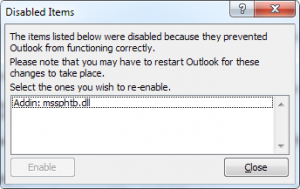
Potential Safe Mode triggers
If you’re using version 2010, your problem is most likely caused by the KB3114409 update that causes Outlook to start in Safe Mode and revert to the default settings. In the event that you’re using an older Outlook version like 2007 or 2003, your issue might be related to Windows Search service. The wrong add-in can also conflict with your Outlook version to the point where you’ll force it to start in Safe Mode.
These are just three of the potential culprits, but the causes can originate from a lot of places.
Below you have a collection of fixes that have already helped a lot of users prevent Outlook from running in Safe mode. Follow the methods above in order according to your Outlook version until you find a fix that solves your problem.
Method 1: Disabling add-ins in Safe Mode (All Outlook versions)
This is a common occurrence on every Outlook version from Outlook 2007 to Outlook 2016. This happens because certain add-ins will conflict with your Outlook version. This is even more likely with outdated add-ins installed on the latest versions of Outlook.
Note: If you installed ABBYY FineReader add-in before this error started happening, follow the steps below to remove the add-in from your Outlook version.
- Confirm that Outlook is in Safe Mode by checking to see if the icon in your taskbar has an exclamation mark.

Note: You can also confirm by looking by seeing if you spot (Safe Mode) in the top section of the screen.
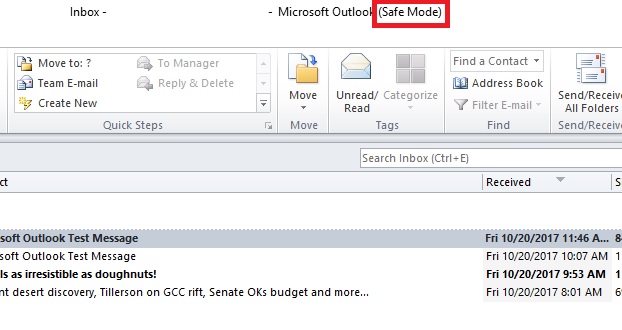
- Now, expand the File tab and click on Options.

- Now click on the Add-ins tab. From there, access the drop-down menu next to Manage and select COM Add-ins from the list. Click on Go to proceed.
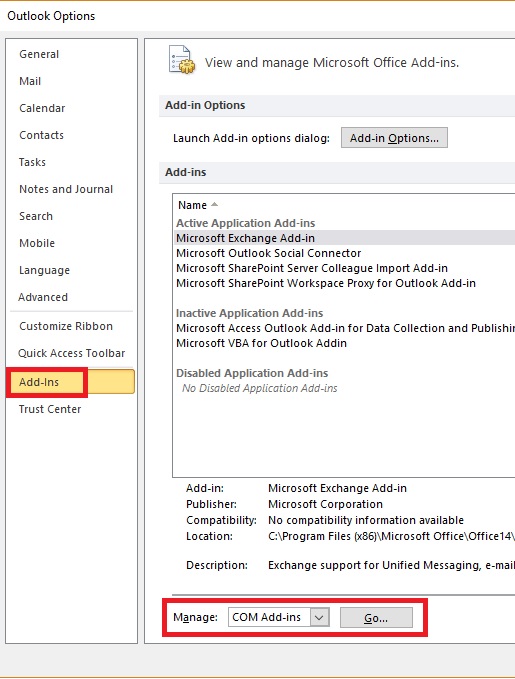
- At this point, you should take a screenshot of the add-in list and save it somewhere convenable. This will help you restore the normal configuration of your Outlook if any malfunctions occur after you disable the add-ins.
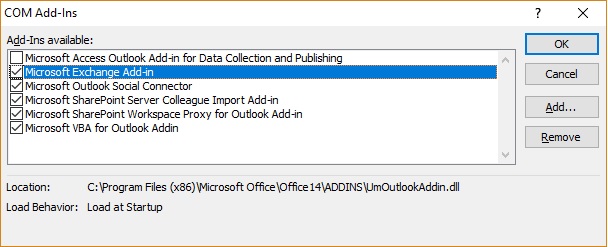
- Disable each entry (clear selected checkboxes) and hit OK.
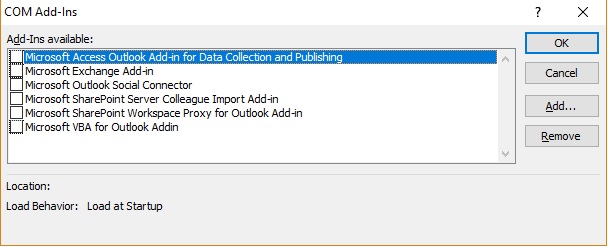 Note: Don’t hit Remove just yet. We first need to confirm that they are causing the issue.
Note: Don’t hit Remove just yet. We first need to confirm that they are causing the issue. - Close Outlook and open it back up again. If the program boots up in normal mode, your issue has been solved.
Note: In the event that it still starts in Safe Mode, go to File Options > Add-ins and re-enable the add-ins we disabled at step 5 and move to Method 2. - Return to File > Option > Add-ins and systematically re-enable each add-in one by one until you reveal the one that is causing conflicts.
- Select it and hit Remove.
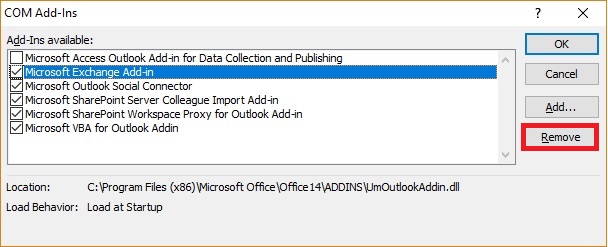
- Restart Outlook and see if it boots up in normal mode.
Method 2: Restore Your Computer Using System Restore (All Outlook versions)
System restore is a Windows feature that allows users to revert their computer state to a previous point in time. This serves our purpose if we can revert to a state previous to where Outlook started malfunctioning. Here’s what to do:
- Hold the Windows Key and Press R. Type rstrui.exe and Click OK.
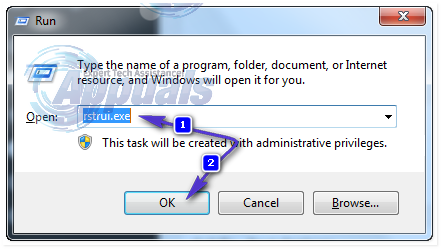
- In the System Restore window, select Choose a different restore point and hit Next.
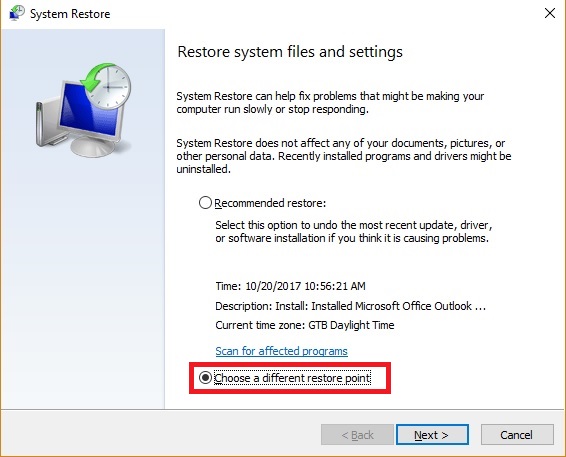
- Thick the box next to Show More Restore Points.
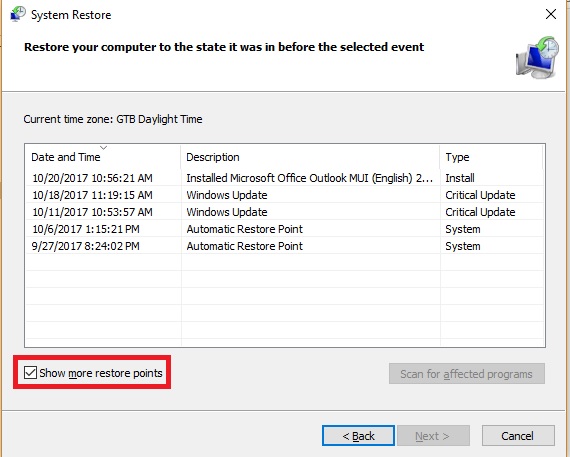
- Locate a point when the Outlook was working, then choose that restore point, and proceed with instructions on the screen to restore the computer to an earlier time.
- Once this is done, the system will begin restoring. After the restore has finished, check to see if Outlook works. if it doesn’t, then proceed to Method 3.
Method 3: Restore to a previous version of Outlook
If restoring your desktop OS to an earlier version didn’t work, let’s try restoring Outlook to a previous version. Here’s how:
- Click Start and type Outlook.exe in the search dialog. Right-click on it and choose Properties.
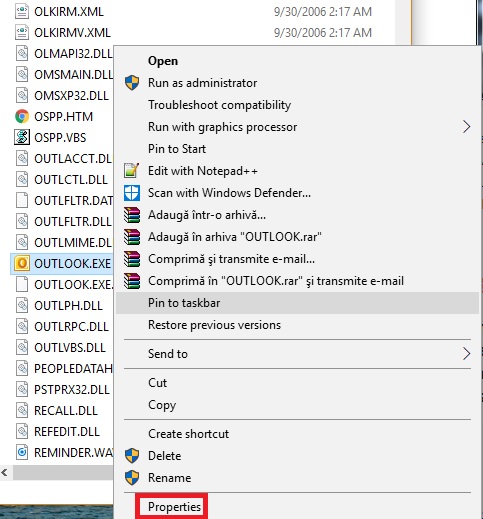
- Then go to the Previous Versions tab, and locate the Outlook.exe file that has a date when it worked. Click Open to see if it works and opens without Safe Mode.
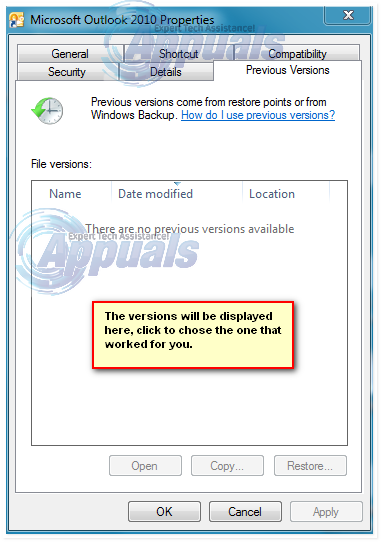 Note: Make sure the non-working Outlook that previously opened in Safe Mode is closed because we are now running one of the copies saved in the previous versions. Do the same for all versions listed there. Open/Close until you see the one that opens without Safe Mode. If it does work, then keep the Window open.
Note: Make sure the non-working Outlook that previously opened in Safe Mode is closed because we are now running one of the copies saved in the previous versions. Do the same for all versions listed there. Open/Close until you see the one that opens without Safe Mode. If it does work, then keep the Window open. - Assuming that you now have the version of Outlook running, without Safe Mode from one of the previous versions. Hold the Windows Key and Press R. Type taskmgr and click OK.
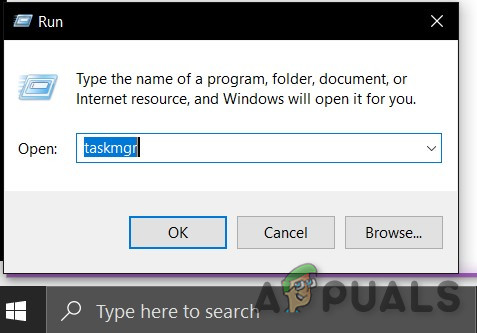
Run “taskmgr” - In the Task Manager Window, Go to the Process Tab, locate Outlook.exe, right-click on it and choose Open File Location.
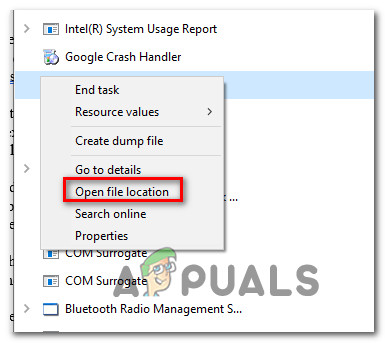
Opening the File location of Outlook - Copy all the files from the next window, then navigate to C:\Program Files (x86)\Microsoft Office\Office. Paste the filed previously copied here.
- Try to re-open Outlook and see if it starts in normal mode.
Method 4: Uninstalling the KB3114409 update ( Outlook 2010)
Sometime in 2015, Microsoft issued a security patch that caused Outlook to run in Safe Mode and revert it back to the default configuration. The user-made configurations aren’t lost forever and will be back when Outlook manages to boot up in normal mode.
If you have this problem, there are two ways to proceed forward. Since Microsoft issued an update that fixes the problem caused by KB3114409, we can install that over the bad update. A different route would be to simply uninstall the KB3114409.
We highly recommend you to go for installing the official Microsoft update fix. But regardless of which option you opt for, we will guide you through the whole process.
Using the official Microsoft fix
Microsoft update KB3114560 was issued specifically to fix the damage done by KB3114409. As a rule of thumb, you should always install security updates from the official website. Here’s what you need to do:
- Access this official link and click on one of the two different update versions, according to your PC specs.
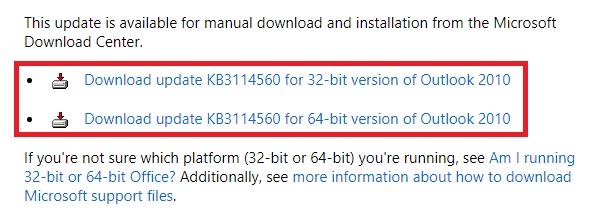
- Select the default language of your Outlook program and click on the Download button.
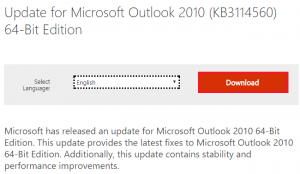
- Once the update has been downloaded, open the executable and follow through with the installation process.
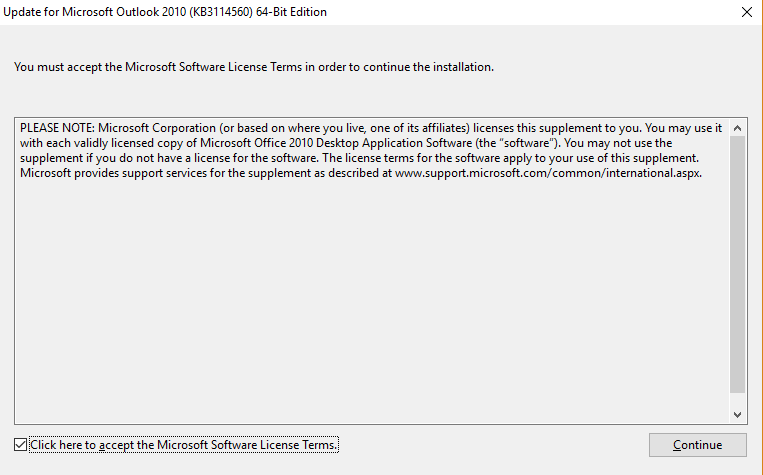
- Restart your PC, open Outlook again and see if the issue has been resolved.
Uninstalling the KB3114409 update
- Close Outlook completely.
- Open Control Panel, click on Uninstall a program.
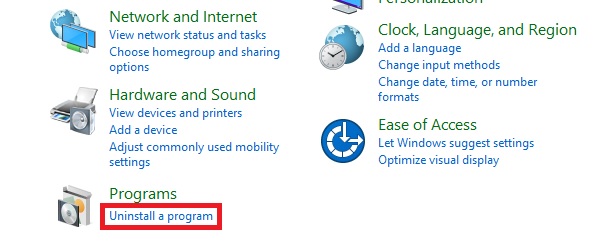
- Once you’re in the Programs and Features window, click on View installed updates.
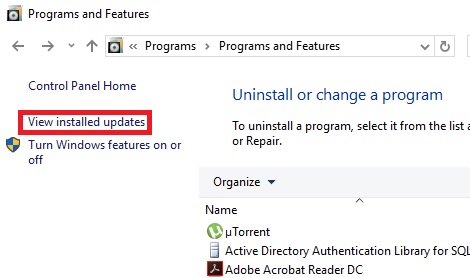
- Use the Search Installed Updates search bar in the top-right corner to search for the bad update ( KB3114409 ).

- Once you manage to identify the bad update, click the Uninstall button and follow through with the confirmation prompts.
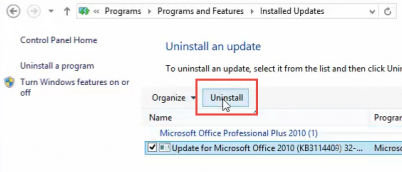
- Restart your PC, open Outlook and see if the issue repeats.
Method 5: Doing an Outlook Profile reset (All Outlook versions)
If you experience hanging at the initial Outlook splash screen (right before it initiates Safe Mode), you might need to do a profile reset. Here’s how to do it:
- Go to Control Panel > Mail and click on Show Profiles.
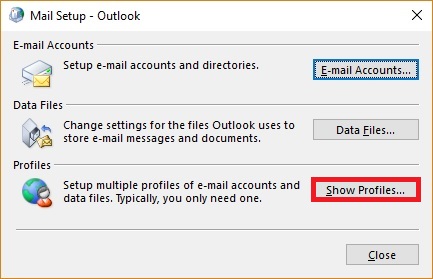
- Now, create a new profile by clicking the Add button. Insert a name and hit OK.

Note: Do not delete the original profile, because we don’t know if this will end up fixing the issue. - Go through the steps of configuring your email account with Outlook. Make sure to use the same email that you have on the already created profile.
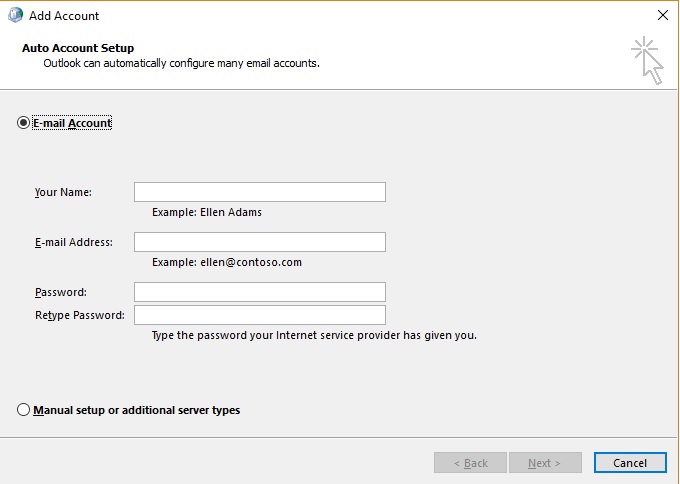
- Now return to the Mail window and make sure the profile you’ve just created is being used by default. Hit Apply to confirm your selection.
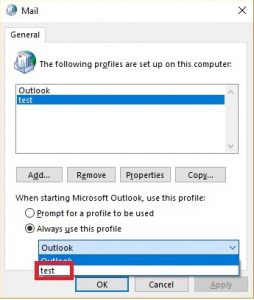
- Start Outlook again and see if it manages to start in normal mode after the profile reset.
Method 6: Checking the PST folder for corruption (All Outlook versions)
Another common cause for Outlook starting in Safe Mode is the Personal Folders File (PST). In the event that it becomes very large, or some files inside are corrupted, it might prevent the program from starting in normal mode. Luckily, you can easily check for corruption by using a Microsoft Repair tool called Scanpst.exe. Here’s what you need to do:
- Close Outlook completely and navigate to C:\ Program Files or C:\ Program Files (x86), depending on which version of Outlook you use.
- Use the search box in the top-right corner to search for SCANPST.exe.
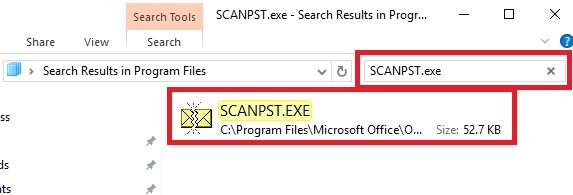 Note: If you don’t manage to find the SCANPST executable via the search bar, you need to navigate to the exact location. Here’s a list of the exact locations based on various Outlook versions:
Note: If you don’t manage to find the SCANPST executable via the search bar, you need to navigate to the exact location. Here’s a list of the exact locations based on various Outlook versions:2016: C:\Program Files (x86)\Microsoft Office\root\Office16 2013: C:\Program Files (x86)\Microsoft Office\Office15 2010: C:\Program Files (x86)\Microsoft Office\Office14 2007: C:\Program Files (x86)\Microsoft Office\Office12
- Open SCANPST.exe and set the path of the PST file you want to scan by using the Browse button. By default, the PST files are stored in Documents\Outlook Files. When you are ready, hit Start to begin the scan.
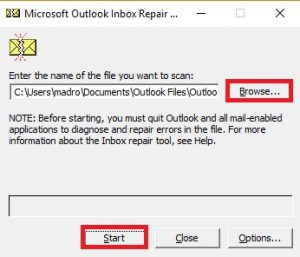
- If the scan uncovers errors or inconsistencies, click on the Repair button to fix them.
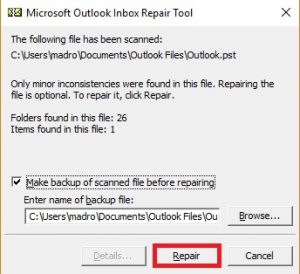
- Once the repair is done, restart Outlook with the profile that you’ve just repaired of errors and see if it starts in normal mode.
Method 7: Running the /resetnavpane command (All Outlook versions)
The navigation pane is that left portion of Outlook where you can oversee your folder list and access various icons to move between calendar, people, tasks, and mails. Sometimes, it can become glitched and prevent Outlook from starting in normal mode. Luckily, there is a command that removes any customizations to the navigation pane and gets rid of any glitch. Even better, this is done outside Outlook with ease. Here’s how:
- Close Outlook completely.
- Go to Start and access the Run application.

- Now, type Outlook.exe /resetnavpane and hit OK.
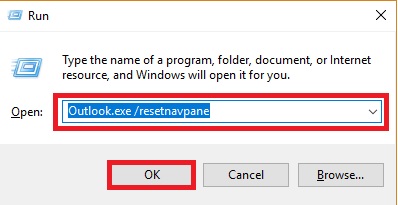 Note: Keep in mind that any customization to the navigation pane will be lost after you click on OK.
Note: Keep in mind that any customization to the navigation pane will be lost after you click on OK. - Shortly after, Outlook should automatically open in normal mode.
Method 8: Disabling compatibility mode
A lot of users have reported that they managed to start Outlook in normal mode after finding out it was running in compatibility mode. Compatibility mode is designed to help a program run as if it was running on an older operating system. As it turns out, turning off compatibility mode might just fix your Outlook Safe Mode problem. Here’s how:
- Close Outlook and navigate to the Outlook.exe on your computer. The exact path of it will differ, depending on your Outlook version. Here’s a list of the exact paths depending on your Outlook version:
2016 - C:\Program Files (x86)\Microsoft Office\root\Office16 2013 - C:\Program Files (x86)\Microsoft Office\Office 15 2010 - C:\Program Files (x86)\Microsoft Office\Office 14 2007: C:\Program Files (x86)\Microsoft Office\Office12
- Right-click on Outlook.exe and click on Properties.
- Now click on the Compatibility tab and make sure the box directly under Compatibility Mode is unchecked. Hit Apply to confirm your selection.
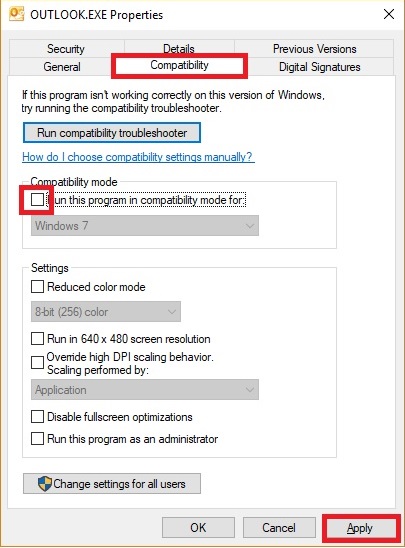
- Finally, open Outlook from the same Outlook executable and see if it manages to start in normal mode.
Method 9: Disabling hardware acceleration (All Outlook versions)
As it turns out, Outlook tries to use hardware acceleration whenever it can to make things as seamless as possible. If you’re Outlook forces itself into Safe Mode, it could very well be an issue with hardware acceleration. We can check to see if that’s the case by making some minor tweaks inside regedit. Here’s how:
- Go to Start and open the Run application.

- Search for regedit and click OK to open the Registry Editor.

- Navigate your way to the following location
HKEY_CURRENT_USER\ Software\ Microsoft\ Office.
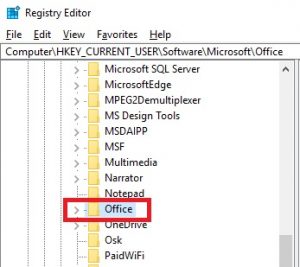
- Now, depending on which Outlook version you have, you might encounter different folders. You should either see a folder named 14.0, 16.0 or 8.0. Either way, click on the folder and double-click on the Common folder.
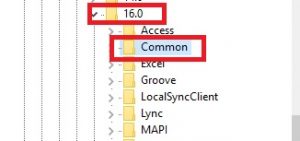
- Right-click anywhere in the Common folder, select New and click on Key and name it Graphics.

- Select the newly created Graphics folder and right-click on the right panel. From there, create a New Dword (32-bit) Value and name it DisableHardwareAcceleration.
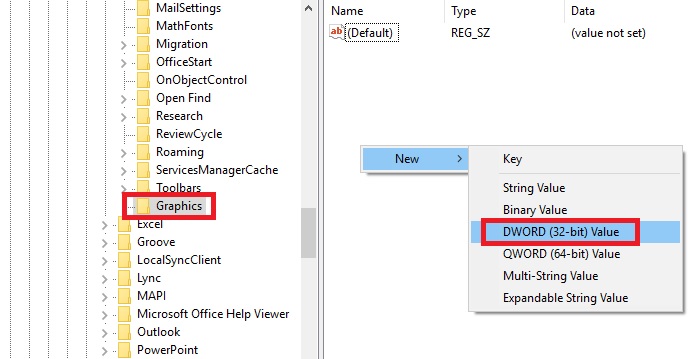
- Now double-click on DisableHardwareAcceleration and set the Value Data to 1 and hit Ok.
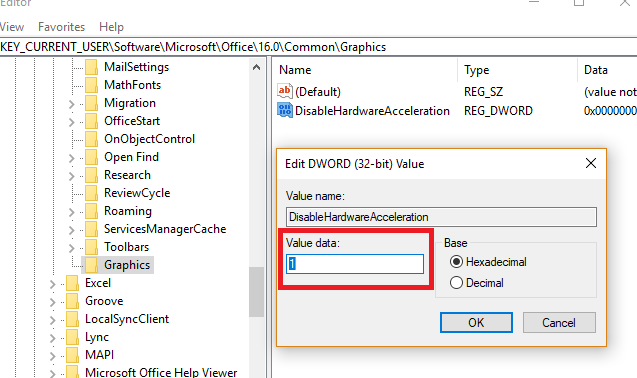
- Close regedit and open Outlook again to see if it starts in normal mode.
Method 10: Resetting the Safe Mode Registry Key (Outlook 2010)
If you have unsuccessfully followed all the methods above, there’s one more thing you can try. A final solution would be to try and prevent Safe Mode from kicking in by tweaking the registry key. But keep in mind that after you’ll follow the steps below, you won’t be able to use Safe mode in the future. At least not until you remove the key that we will create. Here’s what you need to do:
- Go to Start and open the Run application.

- Search for regedit and click OK.

- Navigate your way through HKEY_CURRENT_USER\ Software\ Microsoft\ Office.

- Now, depending on which Outlook version you have, you might encounter different folders. You should either see a folder named 14.0, 16.0 or 8.0. Either way, click on the folder navigate further to Outlook \ Security.
 Note: If the Security folder is missing, Right-click > New > Key and type Security.
Note: If the Security folder is missing, Right-click > New > Key and type Security.
- Right-click on the Security key and choose New > then DWORD (32-bit) Value.
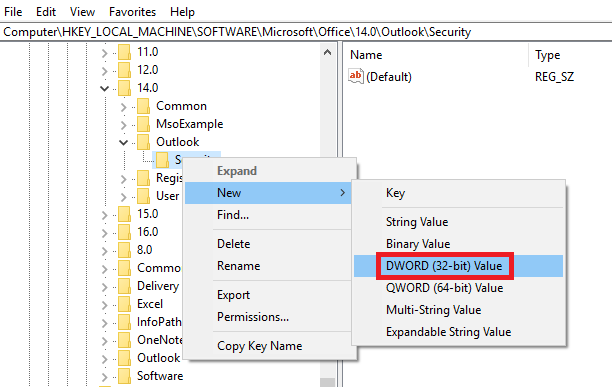
- Name it DisableSafeMode and press Enter to confirm.
- Right-click on DisableSafeMode and click on Modify.
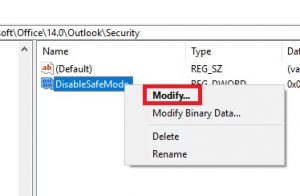
- Insert the value 1 in the Value data box and click OK.
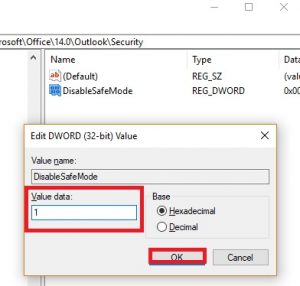
- Quit Registry Editor and reboot your computer.
- Open Outlook and see if it starts up in normal mode.